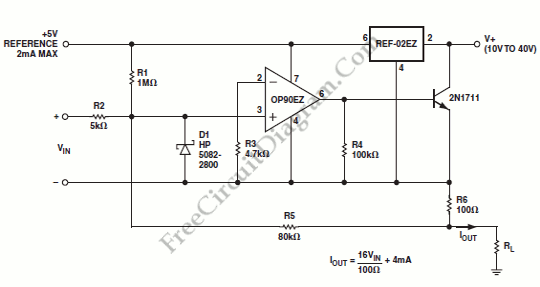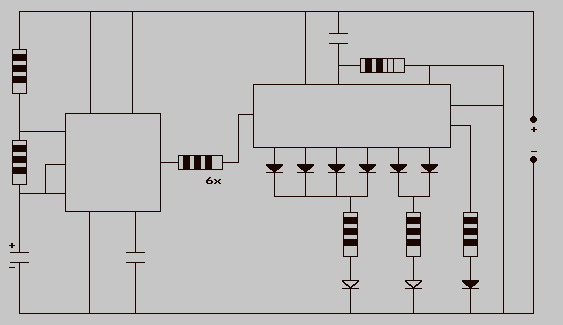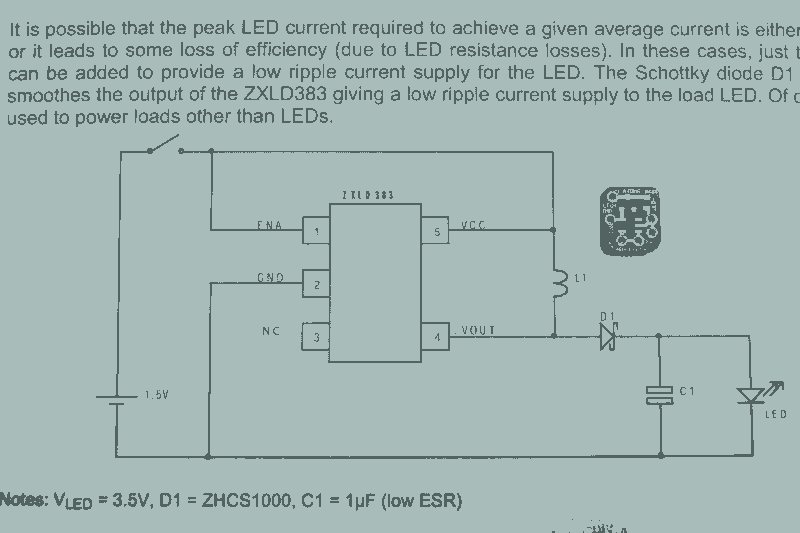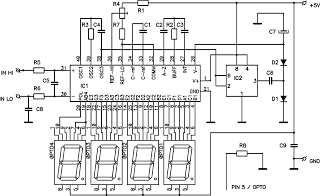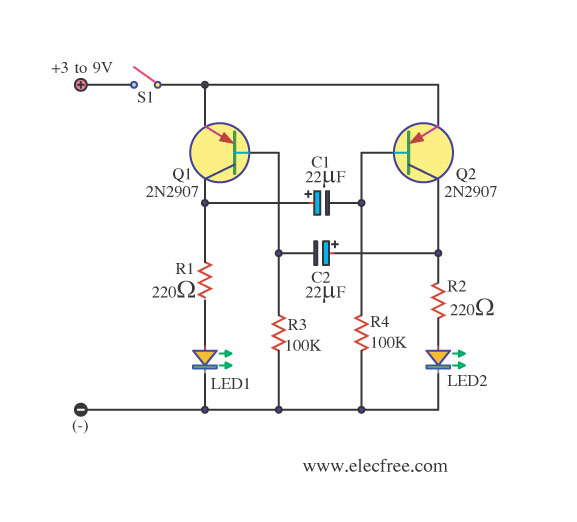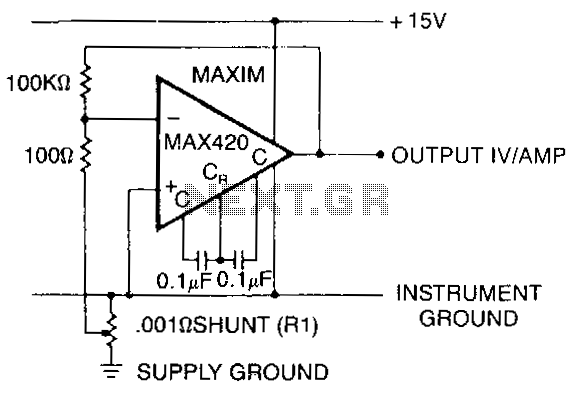
LED current limiter accepts ac or dc
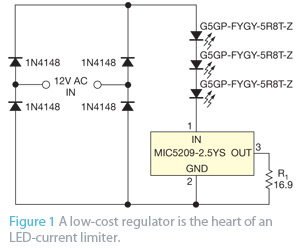
When an application does not require PWM (pulse-width-modulated) dimming or controlled frequency operation, the primary concern may be preventing excessive current that could damage or destroy LEDs. A simple LED current limiter can be created using a common low-dropout linear regulator. The circuit illustrated is an LED light bulb designed for a landscape lighting system. Landscape lighting typically operates at 12V AC, with a peak voltage of approximately 17V. Since the regulator is in series with the LED string, the current through the LED string is equal to the output current of the regulator. The circuit employs reasonably priced, 150-mA warm-white LEDs, low-cost rectifier diodes, and the MIC5209-2.5V regulator from Micrel. The regulator must be capable of sourcing the required LED current and handling the peak input voltage minus the voltage drop across two of the four rectifier diodes and the voltage drop across the LEDs. Choosing a regulator with the lowest possible output and dropout voltages allows the LED current to flow for a larger portion of each AC cycle, thereby reducing the power requirement of the current-setting resistor R1. As the output and dropout voltages decrease, the cost increases. The regulator experiences a peak voltage of approximately 5.1V and dissipates around 0.2W. The MIC5209-2.5V regulates the output voltage to 2.5V between its output and ground. Resistor R1 sets the LED string current using the formula R1 = (2.5 / ILED), where ILED is the LED string current. With a value of 16.9 ohms for R1, the string current is 148 mA. The circuit has a peak dissipation slightly exceeding 2.5W. With an AC input, current flows only about half the time, resulting in an average power dissipation of approximately 1.26W. The circuit can be easily modified to accommodate nearly any input voltage by adjusting the number of LEDs and ensuring that the rectifier diodes can handle the reverse voltage. One LED should be added or subtracted for each 3.33V increase or decrease in peak input voltage. It is advised not to use LEDs as rectifier diodes to achieve more light output, as they do not possess sufficient reverse breakdown voltage and will fail. The input bridge allows for either AC or DC input, eliminating concerns regarding the polarity of a DC input.
The described circuit effectively limits the current supplied to the LED array, ensuring the longevity and reliability of the LEDs in landscape lighting applications. The use of a low-dropout linear regulator, specifically the MIC5209-2.5V, is advantageous as it maintains a stable output voltage while minimizing power loss. The design allows for flexibility in terms of input voltage, making it adaptable to various landscape lighting setups.
The selection of components, such as the warm-white LEDs and rectifier diodes, ensures cost-effectiveness without compromising performance. The calculated values for the resistor R1 are critical for determining the appropriate LED string current, which is necessary for achieving the desired brightness while preventing thermal overload.
In practical applications, the circuit can be further enhanced by incorporating additional features such as thermal protection or overcurrent protection to safeguard the LEDs and the regulator. Furthermore, ensuring proper heat dissipation through adequate thermal management techniques, such as heat sinks or proper ventilation, can extend the operational life of the components involved.
In conclusion, this LED current limiter circuit presents a practical solution for landscape lighting systems, providing a reliable and efficient means of controlling LED current while accommodating various input conditions.When your application requires no PWM (pulse-width-modulated) dimming or controlled frequency operation, your primary concern may be that too much current could damage or destroy your LEDs. In this case, you can make a simple LED-current limiter from a common low-dropoutlinear regulator. The circuit in Figure 1 is an LED light bulb for a landscape-lighting system. Landscape lighting typically operates from 12V ac, and peak voltage is approximately 17V. Because the regulator is in series with the LED string, the LED-string current equals the regulator`s output current. The circuit uses reasonably priced, 150-mA, warm-white LEDs; low-cost rectifier diodes; and Micrel `s 2.
5V MIC5209-2. 5YS regulator (Figure 1). The regulator must source at least the required LED current and handle the peak input voltage minus the drop across two of the four rectifier diodes and the drop across the LEDs. Selecting a regulator with the lowest possible output and dropout voltages lets LED current flow for a larger portion of each ac cycle, and it reduces the power requirement of current-setting resistor R1.
As output and dropout voltages decrease, cost increases. The regulator sees the peak voltage at approximately 5. 1V and dissipates approximately 0. 2W. The MIC5209-2. 5YS` output voltage regulates to 2. 5V between its output and ground. R1 sets the LED-string current using R1=(2. 5/ ILED), where ILED is the LED-string current. With a value of 16. 9 © for R1, the string current is 148 mA. The circuit has slightly more than 2. 5W peak dissipation. With an ac input, the current flows only about half the time, so the average power dissipation is approximately 1. 26W. You can easily modify the circuit to accept almost any input voltage. Simply change the number of LEDs and make sure that the rectifier diodes can handle the reverse voltage.
Add or subtract one LED for each 3. 33V increase or decrease in peak input voltage. Don`t use LEDs for the rectifier diodes to get more light output because LEDs don`t have sufficient reverse-breakdown voltage and will fail. The input bridge accepts either ac or dc and negates the need to worry about the polarity of a dc input.
🔗 External reference
The described circuit effectively limits the current supplied to the LED array, ensuring the longevity and reliability of the LEDs in landscape lighting applications. The use of a low-dropout linear regulator, specifically the MIC5209-2.5V, is advantageous as it maintains a stable output voltage while minimizing power loss. The design allows for flexibility in terms of input voltage, making it adaptable to various landscape lighting setups.
The selection of components, such as the warm-white LEDs and rectifier diodes, ensures cost-effectiveness without compromising performance. The calculated values for the resistor R1 are critical for determining the appropriate LED string current, which is necessary for achieving the desired brightness while preventing thermal overload.
In practical applications, the circuit can be further enhanced by incorporating additional features such as thermal protection or overcurrent protection to safeguard the LEDs and the regulator. Furthermore, ensuring proper heat dissipation through adequate thermal management techniques, such as heat sinks or proper ventilation, can extend the operational life of the components involved.
In conclusion, this LED current limiter circuit presents a practical solution for landscape lighting systems, providing a reliable and efficient means of controlling LED current while accommodating various input conditions.When your application requires no PWM (pulse-width-modulated) dimming or controlled frequency operation, your primary concern may be that too much current could damage or destroy your LEDs. In this case, you can make a simple LED-current limiter from a common low-dropoutlinear regulator. The circuit in Figure 1 is an LED light bulb for a landscape-lighting system. Landscape lighting typically operates from 12V ac, and peak voltage is approximately 17V. Because the regulator is in series with the LED string, the LED-string current equals the regulator`s output current. The circuit uses reasonably priced, 150-mA, warm-white LEDs; low-cost rectifier diodes; and Micrel `s 2.
5V MIC5209-2. 5YS regulator (Figure 1). The regulator must source at least the required LED current and handle the peak input voltage minus the drop across two of the four rectifier diodes and the drop across the LEDs. Selecting a regulator with the lowest possible output and dropout voltages lets LED current flow for a larger portion of each ac cycle, and it reduces the power requirement of current-setting resistor R1.
As output and dropout voltages decrease, cost increases. The regulator sees the peak voltage at approximately 5. 1V and dissipates approximately 0. 2W. The MIC5209-2. 5YS` output voltage regulates to 2. 5V between its output and ground. R1 sets the LED-string current using R1=(2. 5/ ILED), where ILED is the LED-string current. With a value of 16. 9 © for R1, the string current is 148 mA. The circuit has slightly more than 2. 5W peak dissipation. With an ac input, the current flows only about half the time, so the average power dissipation is approximately 1. 26W. You can easily modify the circuit to accept almost any input voltage. Simply change the number of LEDs and make sure that the rectifier diodes can handle the reverse voltage.
Add or subtract one LED for each 3. 33V increase or decrease in peak input voltage. Don`t use LEDs for the rectifier diodes to get more light output because LEDs don`t have sufficient reverse-breakdown voltage and will fail. The input bridge accepts either ac or dc and negates the need to worry about the polarity of a dc input.
🔗 External reference
Warning: include(partials/cookie-banner.php): Failed to open stream: Permission denied in /var/www/html/nextgr/view-circuit.php on line 713
Warning: include(): Failed opening 'partials/cookie-banner.php' for inclusion (include_path='.:/usr/share/php') in /var/www/html/nextgr/view-circuit.php on line 713
